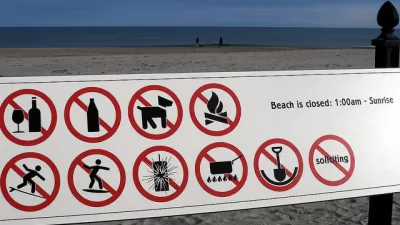Over 80% of Californians live within an hour’s drive of a beach, but that does not mean that everyone has easy access to beaches.

Beaches are some of California and Los Angeles County's most popular and beloved destinations. But not everyone can get to or enjoy them equally. As Frank Shyong reports in this article, there are numerous factors that contribute to inequitable beach access, including (but not limited to):
- Lack of public transit service to some beaches
- Lack of direct connections to some beaches via public transit, requiring transfers and use of multiple bus lines or modes of transportation
- Costs of parking, food, and activities
- Actions by some coastal homeowners, including putting up fake no-parking signs, painting curbs red, installing their own gates and staircases and hiring private security
- Racial bias and the lingering effects of the coast's history of segregation
The article also references a recent study by UCLA's Institute of Environment and Sustainability which offers some valuable data and recommendations regarding coastal access.
On a related note, the Los Angeles County Department of Parks and Recreation (DPR) is currently working on a study to analyze and document the need for facilities like beaches, natural areas, open spaces, regional parks, trails, and local parks in rural areas. As part of this process, DPR is conducting an online survey to better understand whether and how L.A. County residents are using these facilities.
FULL STORY: The beach is there for all of us — we just have to get there

Alabama: Trump Terminates Settlements for Black Communities Harmed By Raw Sewage
Trump deemed the landmark civil rights agreement “illegal DEI and environmental justice policy.”

Planetizen Federal Action Tracker
A weekly monitor of how Trump’s orders and actions are impacting planners and planning in America.

Why Should We Subsidize Public Transportation?
Many public transit agencies face financial stress due to rising costs, declining fare revenue, and declining subsidies. Transit advocates must provide a strong business case for increasing public transit funding.

Understanding Road Diets
An explainer from Momentum highlights the advantages of reducing vehicle lanes in favor of more bike, transit, and pedestrian infrastructure.

New California Law Regulates Warehouse Pollution
A new law tightens building and emissions regulations for large distribution warehouses to mitigate air pollution and traffic in surrounding communities.

Phoenix Announces Opening Date for Light Rail Extension
The South Central extension will connect South Phoenix to downtown and other major hubs starting on June 7.
Urban Design for Planners 1: Software Tools
This six-course series explores essential urban design concepts using open source software and equips planners with the tools they need to participate fully in the urban design process.
Planning for Universal Design
Learn the tools for implementing Universal Design in planning regulations.
Caltrans
Smith Gee Studio
Institute for Housing and Urban Development Studies (IHS)
City of Grandview
Harvard GSD Executive Education
Toledo-Lucas County Plan Commissions
Salt Lake City
NYU Wagner Graduate School of Public Service





























